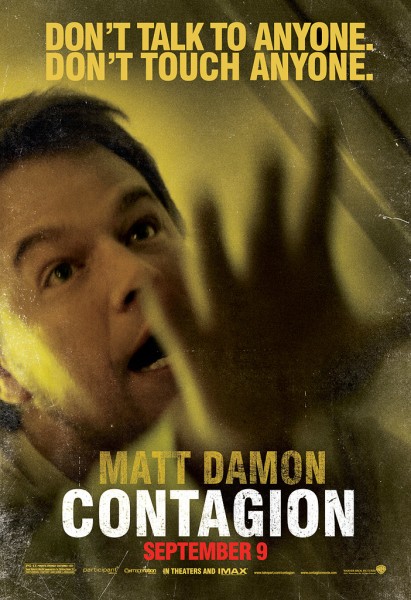Contagion (2011)
Written by Lekha // September 12, 2011 // Media & Popular Culture // 3 Comments

I shun sick people. My heart really goes out to the conjunctivitis/common cold/flu sufferers, but that doesn’t mean I’m going to let them enter my room and touch my stuff. If I didn’t have terribly derisive friends with crippling Facebook addictions, I’d stock food tins and weapons under my bed. Oh, you’re probably thinking I’m one of those paranoid crazies that overreacted during the H1N1 scare by wearing surgical masks and carrying crucifixes. All I have to say is that the buckets of Purell and sharp comments from my “friends” were a small price to pay for a clean bill of health. But I did feel vindicated when Lawrence Fishburne’s character in Contagion says that it is better to be remembered as the health department that overreacted, rather than the health department that sat by and let a disease destroy society.
The first 10 minutes of Contagion are by far the most powerful: a simple montage of people in elevators, eating at restaurants, in conference rooms, in airports and restrooms. The result is that sick feeling in the gut: What did the refreshment stand guy touch before he handed me popcorn? Did the person behind me just cough? Did I just touch my face after that? It’s a dreadful reminder of how vulnerable our cities and lifestyles are to epidemics.
The plot itself is not unlike that of Outbreak (1995) or even 28 Days Later (2002). Everybody knows that etiquette and moral principles are just a veneer: at the first sign of trouble, society will crumble and go Lord of the Flies on each other. While this is a common theme in films, Contagion really stands out in that, it goes to the source of the panic and fear. We may think that inept scientists are only found in Hollywood films, but every now and then you have scientists pulling stunts like this. After all, every one of us is on our own when a crisis occurs but the effects of our actions are manifold. Think of all those irresponsible Facebook and Twitter updates in the aftermath of a terrorist attack, spreading the germs of panic. Similarly, this film does not spare individuals from the terrible consequences of their actions: A blogger talking about a miracle homoeopathy drug results in citywide riots and looting, a housewife telling her friend that she’s buying extra batteries and bottled water results in panic buying, food shortage and closed borders.
Contagion was also extremely plausible because there was no Evil Villain at the root of it all. No pharmaceutical corporation playing God or the CIA trying to bring down an African nation with biological warfare. But that doesn’t mean it was completely lacking in political intrigue. There may have been no cardboard cut-outs, but the hearsay and distrust that governs every relation during times of despair was the real villain, be it developing countries’ certainty that the developed countries were holding back drugs from them, or the finger pointing over the source of origin of the disease, or conspiracy theories about the League of Shadows doing their thing. It’s all a matter of perspective, at the end of the day.
The film had such a star-studded cast, that Steven Soderbergh spent them lavishly (and with good effect). It really speaks for the talent of the actors that despite most of them not getting more than 15 minutes of screen time, they managed to rise above cameo status and brought substance to the film. Of them, Jude Law’s manic intensity as a conspiracy blogger and Marion Cotillard’s reserved performance as a World Health Organisation doctor really took the prize.
You would think that the film ends with the discovery of the miraculous vaccine/cure and (presumably) humanity is saved. But that’s how dime-a-dozen summer blockbusters roll, not Contagion. The vaccine is just the start of another crisis: problems with mass production, distribution and fighting rumours perpetuated by the Jenny McCarthy clan plague the world. None of these are startling revelations: we’ve seen them all happen over the decades, for different diseases, but to see them all unfold in one film reminds us as to how much is at stake over your neighbours’ ablutionary habits.
Easily one of the scariest films of the year, Contagion warns us that today it might be a namby-pamby H1N1 virus, but tomorrow, it could very well be the Rage virus. Just do humanity a favour and stay away from sniffling and coughing people, okay?

3 Comments on "Contagion (2011)"
Good movie, but also hugely frustrating. I liked the realistic feel, but that’s also its biggest flaw – if I want a History Channel documentary on a pandemic, well, I’ll watch History Channel. That’s why for me, it was, like you said, the first 10 minutes that were the most effective in terms of the actual human cost of the virus – and also the second to last sequence when a man finally gets a moment to grieve. While it was great to finally not have another 2012 or Day After Tommorow onslaught of mediocrity, this goes on the other edge to a fault.
I heartily disagree. The whole point of having Matt Damon and his daughter was to provide the human drama, and it was just the right amount too. I mean, there’s a killer infectious disease out there, people surely don’t have time for the whole emotional thing? And Lawrence Fishburne’s moment of panic, despite being the Director of the CDC? Genius. Or how we barely see any of Marion Cotillard, but what she does in the last scene was so touching without being melodramatic.
nice review, lekha!
*cough cough*